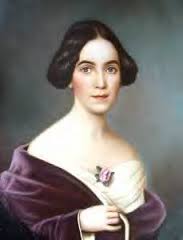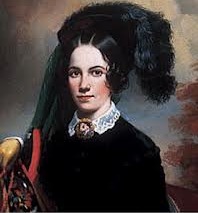 Nashville Plantation Queen, Adelicia Hayes Acklen, was not only Bold, Brilliant and Beautiful, but while the Civil War destroyed most southern fortunes, this Nashville Queen ended the war as one of the richest women in the United States. Adelicia was the daughter of Oliver Bliss Hayes, a prominent Nashville lawyer, judge, Presbyterian minister, land speculator, and cousin to President Rutherford B. Hayes. The Nashville Princess, was born on March 15, 1817 and raised in Sumner County, with several thousands of acres of prime farmland and a few dozen champion show horses to her name. It wouldn’t be long before her wealth and beauty attracted a bevy of suitors to her fathers front door.
Nashville Plantation Queen, Adelicia Hayes Acklen, was not only Bold, Brilliant and Beautiful, but while the Civil War destroyed most southern fortunes, this Nashville Queen ended the war as one of the richest women in the United States. Adelicia was the daughter of Oliver Bliss Hayes, a prominent Nashville lawyer, judge, Presbyterian minister, land speculator, and cousin to President Rutherford B. Hayes. The Nashville Princess, was born on March 15, 1817 and raised in Sumner County, with several thousands of acres of prime farmland and a few dozen champion show horses to her name. It wouldn’t be long before her wealth and beauty attracted a bevy of suitors to her fathers front door.
At 17 years old, Adelicia was engaged to Alphonso Gibbs, a Harvard Law School graduate and son of a prominent Nashville lawyer and banker. Alphonso died of typhoid fever before they could marry, dying lovers would plague or bless Adelicia the rest of her life.
When Adelicia was 22 years old, she married Isaac Franklin, 50, a former slave trader who had become a wealthy businessman and planter. Their seven-year marriage produced four children, who all died in childhood. Franklin was a millionaire when he died in 1846. His estate included half a dozen cotton plantations (8,700 acres) in Louisiana; a 2,000-acre farm in Tennessee; 10,000 to 30,000 acres in Texas; railroad stocks and bonds; several banks; and more than 600 slaves. At the age of 29 years old, Adelicia Hayes Franklin was independently wealthy, worth more than $1 million.
Three years after Franklin’s death, Adelicia married Colonel Joseph A. S. Acklen, a Mexican war hero and a lawyer from Huntsville, Alabama. Acklen signed a prenuptial contract giving his wife complete control of all her businesses, property, and assets. The couple began immediate construction of Belmont, a twenty-thousand-square-foot summer villa outside of Nashville. The Acklens lived a sumptuous lifestyle, traveling between Belmont in the summer and their Louisiana plantations in the winter. The couple had six children, two of whom died young. Acklen, a superb businessman and plantation manager, had more than tripled his wife’s fortune.
Belmont Mansion was built in the style of an Italian villa and was set among elaborate gardens. There were numerous outbuildings, including a water tower, that provided irrigation for the gardens and supplied water for the fountains. There was also a bowling alley, a bear house and a zoo. Adelicia Acklen opened the estate to the citizens of Nashville to enjoy the zoo, as no public zoos existed at the time.
In 1859, the Acklens hired Adolphus Heiman, a Prussian born architect working in Nashville, to enlarge and remodel Belmont Mansion. Heiman enclosed the back porch to create the Grand Salon, a very large room containing a French-style, barrel-vaulted ceiling. With this new addition, Belmont Mansion contained 36 rooms and approximately 10,000 square feet of living space. An additional 8,400 square feet of service area was located in the basement. The house was filled with fine furniture, paintings, and marble statues.
In 1863, after her husband died, Adelicia Acklen faced financial ruin when the Confederate army threatened to burn 2,800 bales of her cotton to keep it from falling into Union possession. Acklen boldly rushed to Louisiana and secretly negotiated with both sides to save her fortune. She secured Confederate promises not to burn her cotton, while the Union army agreed to help her move the cotton to New Orleans. With these assurances, Acklen ran the Union blockade instead and sold her cotton to the Rothschilds of London for a reported $960,000 in gold.
 The house and extensive grounds on the outskirts of Nashville were occupied in December 1864, just before the Battle of Nashville, by 3000 Union soldiers. Acklen, with her strong New England family connections and multiple social circles, came into contact with prominent citizens such as Sarah Childress Polk, the former first lady of the United States and it is likely that she sought protection from Union officers at high levels to protect her holdings at Nashville and Louisiana.
The house and extensive grounds on the outskirts of Nashville were occupied in December 1864, just before the Battle of Nashville, by 3000 Union soldiers. Acklen, with her strong New England family connections and multiple social circles, came into contact with prominent citizens such as Sarah Childress Polk, the former first lady of the United States and it is likely that she sought protection from Union officers at high levels to protect her holdings at Nashville and Louisiana.
Three weeks after Robert E. Lee’s surrender in 1865, Acklen and her children left for Europe to retrieve the money made from the Rothschilds.
In 1867, Adelicia married Dr. William Cheatham, a prominent Nashville physician, who also signed a prenuptial agreement. Their wedding reception took place at Belmont, with about 2,000 guests in attendance. By the 1880s, Adelicia began spending more time in Washington, D.C., often with her only surviving daughter, Pauline.
In 1887, Adelicia sold Belmont Mansion to a land development company and permanently moved to Washington D.C. without her husband Cheatham. Later that year, she contracted pneumonia while on a shopping trip to New York City and died in a Fifth Avenue hotel. Her body was returned to Nashville and buried in the family mausoleum at Mount Olivet Cemetery.
Nashville Plantation Queen, Adelicia Hayes Acklen Cheatham, was Bold, Brilliant and Beautiful, in addition, she exemplified how a woman did not need a man’s guiding hand to weather the treacherous business of finance, during the Civil War.
Bummer


What a great story, thanks for posting it
Susan,
Glad you enjoyed the Nashville Queen and her tale. Thanks for visiting,
Bummer
I’ve been to Belmont Mansion before but never knew so much about the people who built it and lived there. Great post.
Louis,
Fascinating people and Belmont seems other worldly. Super smart gal and knew how to keep what she had. Unusual for a woman at that period of time. Her father could have had a lot of stroke in the community. Thanks for the read!
Bummer